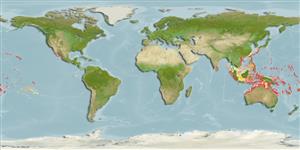分类 / Names
俗名 | 同种异名 | Catalog of Fishes(属, 种) | ITIS | CoL | WoRMS | Cloffa
Teleostei >
Ovalentaria/misc (Various families in series Ovalentaria)
鱸形目 (Various families in series Ovalentaria) >
Pomacentridae (Damselfishes)
雀鯛科(Damselfishes) (Damselfishes) > Chrominae
Etymology: Chromis: Greek, chromis = a fish, perhaps a perch (Ref. 45335).
More on author: Bleeker.
Environment: milieu / climate zone / depth range / distribution range
生态学
海洋 礁区鱼类; 非迁移的; 深度上下限 0 - 40 m (Ref. 7247). 热带; 35°N - 25°S
Western Pacific: widespread, from southern Japan to Australia and Tonga; no records from Hawaii nor French Polynesia. Replaced by Chromis opercularis in the Indian Ocean (Ref. 129596).
太平洋: 在东印度洋到大洋洲的岛屿 (除了夏威夷群岛) 中的圣诞岛与澳洲西北部的外海礁石. 记录来自马尔地夫 (参考文献 5579) ,日本与台湾了。 (参考文献 1602 与 4868, 分别地) 在西印度洋被 Chromis opercularis 取代了。 (参考文献 37816)
大小 / 重量 / 年龄
Maturity: Lm ? range ? - ? cm
Max length : 17.0 cm TL 雄鱼/尚未辨别雌雄; (Ref. 90102)
背棘 (总数) : 13; 背的软条 (总数) : 10 - 11; 臀棘: 2; 臀鳍软条: 10 - 11. This species is distinguished by the following set of characters: D XIII,10-11(mode 11); A II,10-11 (11); pectoral-fin rays 18-20 (19); upper and lower procurrent caudal-fin rays 3; pored lateral-line scales 17-18 (18); gill rakers 6-8 (7) + 19-22 (21) = 26-30 (28); longest dorsal-fin soft ray length 24.6-36.4% (mean 29.4%) of SL; first anal-fin spine length 6.5-8.4% (7.1%) of SL; caudal-fin length 43.9-59.8% (48.6%) of SL; posterior tips of caudal-fin lobes are filamentous; broad black bands along the preopercular and opercular margins, sum width of two bands 15.3-27.9% (23.6%) of head length; distal half of soft-rayed portion of the dorsal fin is transparent in adults; upper or lower caudal-fin base no triangular black blotches; caudal peduncle and fin are tinged with yellow; soft-rayed portions of dorsal and anal fins are yellowish, with spinous portion of dorsal and pelvic fins dark blue in juveniles (Ref. 129596).
鱼随着体型大小与栖地展现色彩变化。 稚鱼是暗蓝灰色到一色彩艳丽的铁蓝色的具有一个鲜橘色-黄色的尾部。 成鱼是深灰色到黑色的, 而且在大多数的区域中有一个白色的尾部。
Adults are found in steep outer reef slopes and shallow coastal reef flats, sometimes forming large aggregations feeding on zooplankton several meters above the bottom. Juveniles remain close to shelter. Oviparous, distinct pairing during breeding (Ref. 205). Eggs are demersal and adhere to the substrate (Ref. 205). Nests are found in small patches of loose sand under ledges or at the base of slopes (Ref. 9710). Males guard and aerate the eggs (Ref. 205). Diurnal species (Ref. 54980; 113699). Minimum depth reported taken from Ref. 128797.
发现于陡峭的外礁斜坡与水浅的海岸礁石平台了, 有时形成大的群集捕食浮游动物在底部上面的数公尺。 稚鱼保持接近庇护所。 筑巢在岩架下松散的砂小区块中或在斜坡的基底.(参考文献 9710)
Life cycle and mating behavior
Maturities | 繁殖 | Spawnings | Egg(s) | Fecundities | 仔鱼
Oviparous, distinct pairing during breeding (Ref. 205). Eggs are demersal and adhere to the substrate (Ref. 205). Males guard and aerate the eggs (Ref. 205).太平洋: 在东印度洋到大洋洲的岛屿 (除了夏威夷群岛) 中的圣诞岛与澳洲西北部的外海礁石. 记录来自马尔地夫 (参考文献 5579) ,日本与台湾了。 (参考文献 1602 与 4868, 分别地) 在西印度洋被 Chromis opercularis 取代了。 (参考文献 37816)
Allen, G.R., 1991. Damselfishes of the world. Mergus Publishers, Melle, Germany. 271 p. (Ref. 7247)
人类利用
渔业: 商业性; 水族馆: 商业性
工具
特别资料
下载 XML
网络资源
Estimates based on models
Preferred temperature (Ref.
123201): 24.7 - 28.9, mean 27.7 °C (based on 424 cells).
Phylogenetic diversity index (Ref.
82804): PD
50 = 0.5000 [Uniqueness, from 0.5 = low to 2.0 = high].
Bayesian length-weight: a=0.01413 (0.00668 - 0.02988), b=2.94 (2.77 - 3.11), in cm total length, based on LWR estimates for this species & Genus-body shape (Ref.
93245).
营养阶层 (Ref.
69278): 3.4 ±0.45 se; based on food items.
回复力 (Ref.
120179): 中等的, 族群倍增时间最少 1.4 - 4.4年 (Preliminary K or Fecundity.).
Fishing Vulnerability (Ref.
59153): Low vulnerability (10 of 100).
Nutrients (Ref.
124155): Calcium = 79.2 [39.4, 122.1] mg/100g; Iron = 0.721 [0.430, 1.172] mg/100g; Protein = 18.3 [17.2, 19.4] %; Omega3 = 0.116 [0.070, 0.190] g/100g; Selenium = 25.6 [13.4, 49.3] μg/100g; VitaminA = 132 [39, 433] μg/100g; Zinc = 1.25 [0.83, 1.78] mg/100g (wet weight);
